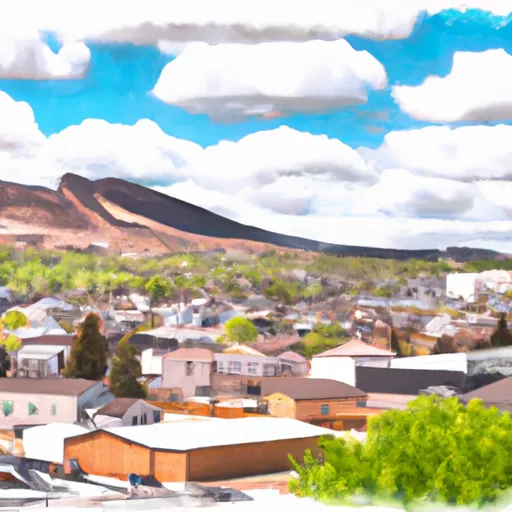-
 Snoflo Premium
Snoflo Premium
Get unlimited access to all our content
With no Ad interruptions! - Start Your Free Trial Login with existing account
La-Verkin
Eden Index
Climate
9.0
•
Recreation
6.5
•
Community
2.7
•
Safeguard
6.5/10

La Verkin, Utah, is a small town located in the southwestern part of the state. It experiences a warm desert climate with hot summers and mild winters. Summers are typically dry and scorching, with temperatures often exceeding 100°F (38°C), while winters are mild with average temperatures ranging from 30°F (-1°C) to 50°F (10°C). The town is known for its stunning natural beauty, surrounded by red rock cliffs and canyons.
Hydrologically, La Verkin is situated near the Virgin River, which provides water for irrigation and supports diverse wildlife. The river is also a popular spot for recreational activities such as fishing, kayaking, and rafting.
Outdoor recreation opportunities in La Verkin and its vicinity are abundant. The nearby Zion National Park offers a wealth of activities, including hiking through breathtaking canyons, rock climbing, and camping. The nearby Hurricane Cliffs and Pine Valley Mountains provide opportunities for mountain biking, off-roading, and horseback riding. Additionally, the nearby Sand Hollow Reservoir offers boating, swimming, and fishing opportunities.
Overall, La Verkin, Utah, provides a warm desert climate, access to the Virgin River, and a variety of outdoor recreational activities, making it an appealing destination for nature lovers and adventure enthusiasts.
What is the Eden Index?
The Snoflo Eden Index serves as a comprehensive rating system for regions, evaluating their desirability through a holistic assessment of climate health, outdoor recreation opportunities, and natural disaster risk, acknowledging the profound impact of these factors on livability and well-being.
Climate Health Indicator (CHI): 9.0
La-Verkin receives approximately
313mm of rain per year,
with humidity levels near 52%
and air temperatures averaging around
16°C.
La-Verkin has a plant hardyness factor of
8, meaning
plants and agriculture in this region tend to thrive here all year round.
By considering the ideal temperature range, reliable water supplies, clean air, and stable seasonal rain or snowpacks, the Climate Health Indicator (CHI) underscores the significance of a healthy climate as the foundation for quality living.
A healthy climate is paramount for ensuring a high quality of life and livability in a region, fostering both physical well-being and environmental harmony. This can be characterized by ideal temperatures, reliable access to water supplies, clean air, and consistent seasonal rain or snowpacks.
Weather Forecast
Streamflow Conditions
Lower Colorado-Lake Mead
Area Rivers
Lower Colorado-Lake Mead
Snowpack Depths
Lower Colorado-Lake Mead
Reservoir Storage Capacity
Lower Colorado-Lake Mead
Groundwater Levels
Recreational Opportunity Index (ROI): 6.5
The Recreational Opportunity Index (ROI) recognizes the value of outdoor recreational options, such as parks, hiking trails, camping sites, and fishing spots, while acknowledging that climate plays a pivotal role in ensuring the comfort and consistency of these experiences.
Access to outdoor recreational opportunities, encompassing activities such as parks, hiking, camping, and fishing, is crucial for overall well-being, and the climate plays a pivotal role in enabling and enhancing these experiences, ensuring that individuals can engage in nature-based activities comfortably and consistently.
Camping Areas
| Campground | Campsites | Reservations | Toilets | Showers | Elevation |
|---|---|---|---|---|---|
| Washington County Regional Park | None | 2,891 ft | |||
| Red Cliffs | 10 | 3,237 ft | |||
| Pine Valley Rec Area | None | 6,767 ft | |||
| Sand Hollow State Park | None | 3,055 ft | |||
| Quail Creek State Park | 23 | 2,997 ft |
Catastrophe Safeguard Index (CSI):
The Catastrophe Safeguard Index (CSI) recognizes that natural disaster risk, encompassing floods, fires, hurricanes, and tornadoes, can drastically affect safety and the overall appeal of an area.
The level of natural disaster risk in a region significantly affects safety and the overall livability, with climate change amplifying these risks by potentially increasing the frequency and intensity of events like floods, fires, hurricanes, and tornadoes, thereby posing substantial challenges to community resilience and well-being.
Community Resilience Indicator (CRI): 2.7
The Community Resilience Indicator (CRI) recognizes that education, healthcare, and socioeconomics are crucial to the well-being of a region. The CRI acknowledges the profound impact of these elements on residents' overall quality of life. By evaluating educational resources, healthcare accessibility, and economic inclusivity, the index captures the essential aspects that contribute to a thriving community, fostering resident satisfaction, equity, and social cohesion.

